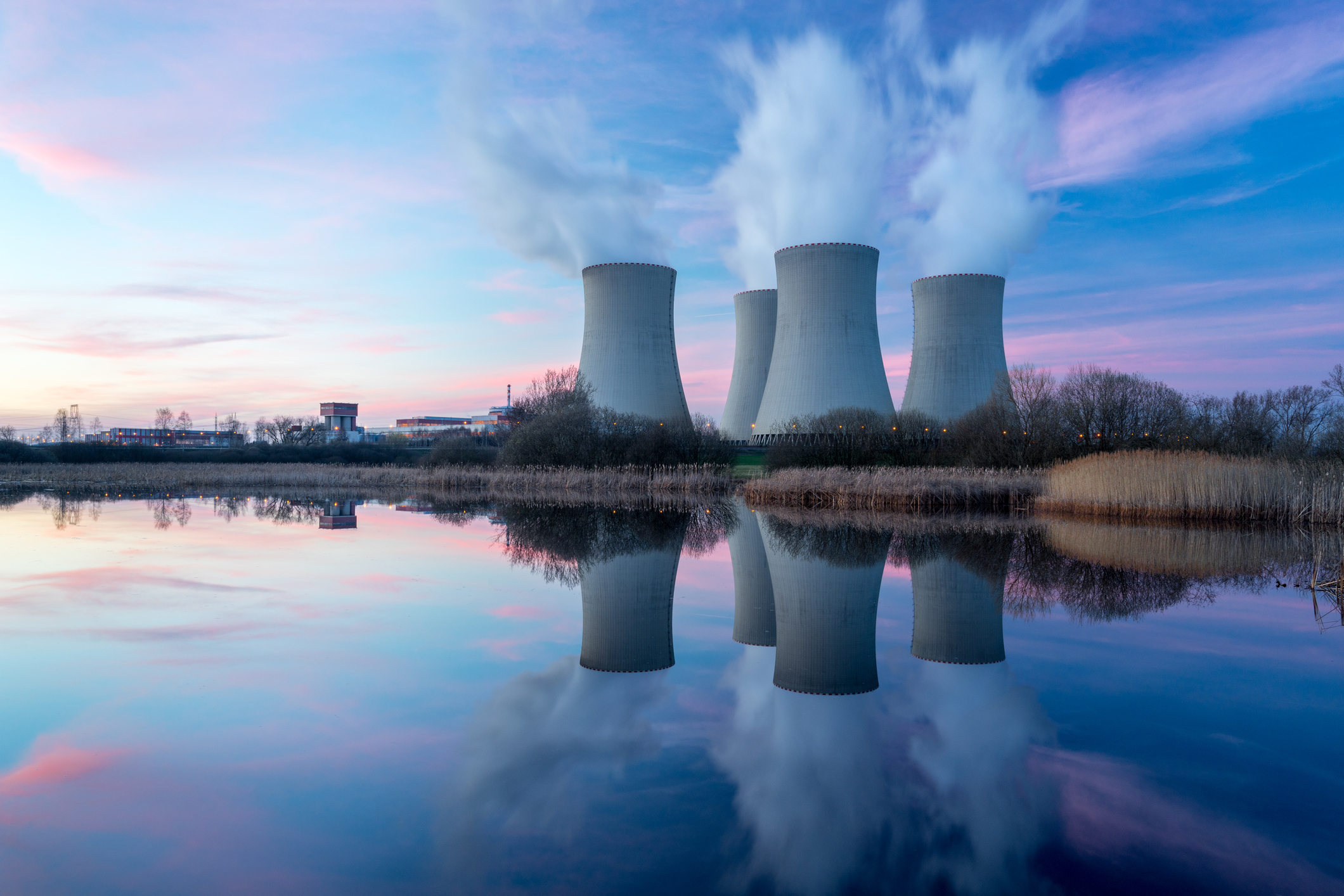Nuclear energy stocks have become far more compelling to many investors in recent years. Between the implications of climate change, the limits on solar and wind energy and storage technology, the still-high costs of hydrogen energy, and decades of data that support nuclear energy as safe, there are good reasons to support this carbon-free source of energy.
But before jumping into the latest hot nuclear energy stock, it pays to know what you're getting into. In this article, we'll break down the nuclear energy industry, opportunities, risks, and what investors need to understand.

Understanding nuclear energy
Without diving too deeply into the science, nuclear energy, in general, refers to fission. Here's how it works:
- Uranium-235, which is an enriched isotope of the more common uranium-238, is split.
- As the uranium isotope is split, it starts a chain reaction, generating heat and radiation.
- A cooling agent (usually water) is heated by the process, and steam powers a turbine.
- The turbine generates electricity.
A few caveats:
- The fuel for almost all nuclear fission is uranium-235, the isotope that can produce a fission chain reaction. Most uranium mining companies are fairly specialized.
- Because more than 99% of the world's supply is uranium-238, most must be enriched into uranium-235 -- a lucrative business for the small number of companies that do it.
- Only a small handful of companies have the expertise and financial strength to deal with nuclear reactors.
- Commercial nuclear reactors have been very large in scale to maximize efficiency, since smaller-scale reactors could not compete on efficiency.
Looking beyond fission, there have been major advances in nuclear fusion in recent years. Long considered the holy grail of energy, fusion is, to quote the International Atomic Energy Agency, "the process by which two light atomic nuclei combine to form a single heavier one while releasing massive amounts of energy."
Fusion could provide virtually limitless clean, safe, and affordable energy to meet the world's energy demand. The problem: It's incredibly hard; we are talking about the equivalent of making miniature suns, after all.
But the upside is almost immeasurable. Fusion would be significantly safer and cleaner than any other source of energy under humanity's control today. But we still don't know how many more decades before fusion is more than just an expensive experiment, much less anywhere close to commercially viable. And we need more clean energy now.
Back to fusion. After many years of negative sentiment, nuclear energy is back on the table -- for good reasons, based on its clean-energy bona fides and a safety record that has been marred by a small number of high-profile events but is far safer than many people think.
Up next, let's take a closer look at five top nuclear energy stocks.
Five top nuclear energy stocks
1. Cameco
One of the few well-established pure-play companies to invest in nuclear energy stocks, Cameco is among the world's largest uranium miners and refiners. This Canadian company's Cigar Lake facility produces the world's highest-grade uranium and has produced more than 155 million pounds since going online in 2015.

NYSE: CCJ
Key Data Points
Its McArthur River/Key Lake facility came back into operation in 2022 after being shut down for several years. Cameco's operations there have produced 567.9 million pounds of uranium from the largest high-grade uranium mine and mill in the world. Cameco also produces uranium hexafluoride and uranium dioxide, which are used in uranium enrichment and fuel rod production.
Like many other natural resources companies, Cameco is heavily affected by the cyclical pricing of the underlying commodities it produces and sells. As a result of these commodity swings, it can be a very cyclical stock, going through boom-and-bust periods when its earnings can spike and then fall sharply before recovering again.
The good news is that despite this cyclical reality, Cameco has a long track record of generating strong positive operating cash flow. It has generated positive operating cash every year since 2010.
In mid-2025, Cameco's share price was riding high on high uranium prices and the promise of a nuclear renaissance. But as with other cyclical, commodity-price-driven stocks, it's important to exercise patience, determine a reasonable valuation, and monitor current events.
The company reduced its production forecast for 2025 in August because of expansion delays at McArthur River. With a strong record of making money, Cameco is a great business. But investors should make sure to buy shares at a good valuation and avoid overpaying when uranium prices are high.
2. GE Vernova
General Electric completed its decade-long restructuring in April 2024. The legacy business was split into its remaining stand-alone entities, with GE Aerospace (GE +0.05%) keeping the stock ticker and CEO Larry Culp, and its energy business now standing on its own as GE Vernova.

NYSE: GEV
Key Data Points
The new energy-focused company has been good to shareholders so far, and investors interested in nuclear should consider owning it. GE has been in the nuclear power business since the 1950s, and Vernova is one of a handful of companies with significant market share in nuclear reactors.
The spinoff of GE Vernova includes GE's nuclear business; part of its Power segment, which also includes its gas, steam, and hydroelectric business; its Wind segment; and its Electrification segment. A few things make this GE spinoff a compelling nuclear energy stock. As a starting point, Vernova's allocation of capital as a standalone, energy-focused company should deliver better results.
Beyond GE Hitachi Nuclear Energy, the nuclear reactors and services spinoff, investors will also get exposure to GE's leading gas, hydroelectric, and steam power technologies, as well as its leading onshore and offshore wind energy business. Combined, that's a global market of more than $265 billion that GE Vernova can serve.
Part of GE Vernova's growth market includes small modular reactors (SMRs), which are expected to be an important part of a more decentralized and flexible electric grid. The company received permission in mid-2025 to begin construction on an SMR in Ontario that would be the first reactor of its type in the Western hemisphere, capable of powering roughly 300,000 homes.
3. Brookfield Renewable
Like GE Vernova, this isn't a pure-play nuclear energy stock. Brookfield Renewable owns, operates, and invests in hydroelectric, wind, solar, and energy storage facilities today.

NYSE: BEP
Key Data Points
The company signed a 20-year power production agreement (PPA) with Microsoft (MSFT -1.98%) in September 2024 to support the launch of the Crane Clean Energy Center -- formerly known as Three Mile Island -- slated for 2028. The agreement gives 835 megawatts of power to the tech giant for data center operations.
Constellation also plans to offer nuclear power from the 1.1 GW Clinton Clean Energy Center, which has been heavily subsidized by Illinois taxpayers due to poor economics.
Constellation is expected to become the largest clean energy producer when it closes its $26.6 billion acquisition of Calpine. The deal is expected to boost its capacity to more than 60 GW while increasing earnings per share (EPS) by more than 20% and adding $2 billion to its annual free cash flow.
5. NuScale Power
Investors looking for more pure-play nuclear companies and a high risk tolerance level may prefer a company like NuScale, a start-up that's trying to take small-scale reactors commercial. The company's stock has been boosted by the Trump administration's plans to loosen regulations for new nuclear plants and boost the production of small modular reactors (SMRs).

NYSE: SMR
Key Data Points
And while the U.S. Army announced an initiative to build small reactors to power its hundreds of military installations in the United States, NuScale should still be treated as an extremely speculative investment. While NuScale could prove a huge winner, it's still very early in its existence.
It went public via a special purpose acquisition company (SPAC) in May 2022 and isn't likely to have its first VOYGR SMR power plant fully operational in the U.S. anytime soon. NuScale pulled the plug on a Utah reactor project in November 2023 and currently has no new projects announced with a definitive completion date.
Related investing topics
Should you invest in nuclear energy?
After decades of being out of favor, nuclear energy is hanging out with the popular kids again. And that's likely to be good for the world since more low-carbon energy should result in more economic opportunity, a better environment, and better health outcomes for billions of people. Nascent technologies like small-scale reactors might be appealing, too.
But before piling into nuclear energy stocks, make sure to check your biases and your reasoning. Nuclear energy is a cyclical industry that's come back into favor, so the headlines (and message boards) can make it feel like a can't-miss opportunity.
But that's far from the reality; while the secular trends look favorable, today's profits can turn into losses before you can say, "But what about last quarter?" So, step lightly and consider the risks before you buy.

